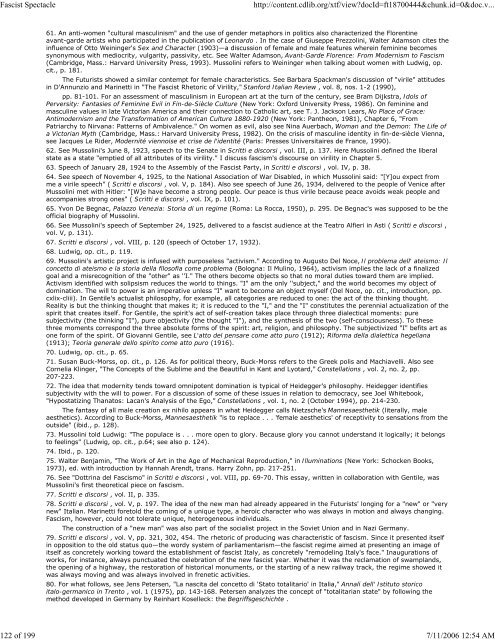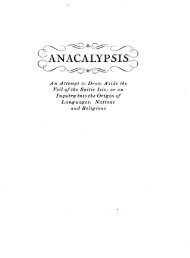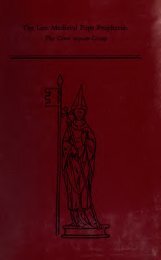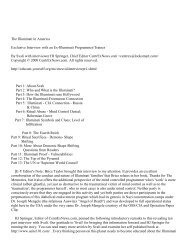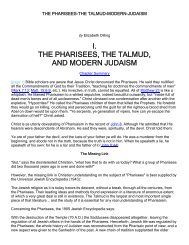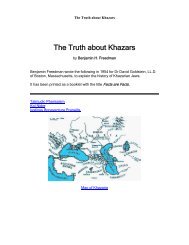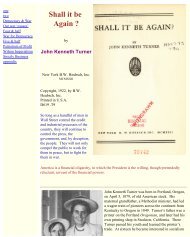Create successful ePaper yourself
Turn your PDF publications into a flip-book with our unique Google optimized e-Paper software.
<strong>Fascist</strong> <strong>Spectacle</strong> http://content.cdlib.org/xtf/view?docId=ft18700444&chunk.id=0&doc.v...<br />
61. An anti-women "cultural masculinism" and the use of gender metaphors in politics also characterized the Florentine<br />
avant-garde artists who participated in the publication of Leonardo . In the case of Giuseppe Prezzolini, Walter Adamson cites the<br />
influence of Otto Weininger's Sex and Character (1903)—a discussion of female and male features wherein feminine becomes<br />
synonymous with mediocrity, vulgarity, passivity, etc. See Walter Adamson, Avant-Garde Florence: From Modernism to Fascism<br />
(Cambridge, Mass.: Harvard University Press, 1993). Mussolini refers to Weininger when talking about women with Ludwig, op.<br />
cit., p. 181.<br />
The Futurists showed a similar contempt for female characteristics. See Barbara Spackman's discussion of "virile" attitudes<br />
in D'Annunzio and Marinetti in "The <strong>Fascist</strong> Rhetoric of Virility," Stanford Italian Review , vol. 8, nos. 1-2 (1990),<br />
pp. 81-101. For an assessment of masculinism in European art at the turn of the century, see Bram Dijkstra, Idols of<br />
Perversity: Fantasies of Feminine Evil in Fin-de-Siècle Culture (New York: Oxford University Press, 1986). On feminine and<br />
masculine values in late Victorian America and their connection to Catholic art, see T. J. Jackson Lears, No Place of Grace:<br />
Antimodernism and the Transformation of American Culture 1880-1920 (New York: Pantheon, 1981), Chapter 6, "From<br />
Patriarchy to Nirvana: Patterns of Ambivalence." On women as evil, also see Nina Auerbach, Woman and the Demon: The Life of<br />
a Victorian Myth (Cambridge, Mass.: Harvard University Press, 1982). On the crisis of masculine identity in fin-de-siècle Vienna,<br />
see Jacques Le Rider, Modernité viennoise et crise de l'identité (Paris: Presses Universitaires de France, 1990).<br />
62. See Mussolini's June 8, 1923, speech to the Senate in Scritti e discorsi , vol. III, p. 137. Here Mussolini defined the liberal<br />
state as a state "emptied of all attributes of its virility." I discuss fascism's discourse on virility in Chapter 5.<br />
63. Speech of January 28, 1924 to the Assembly of the <strong>Fascist</strong> Party, in Scritti e discorsi , vol. IV, p. 38.<br />
64. See speech of November 4, 1925, to the National Association of War Disabled, in which Mussolini said: "[Y]ou expect from<br />
me a virile speech" ( Scritti e discorsi , vol. V, p. 184). Also see speech of June 26, 1934, delivered to the people of Venice after<br />
Mussolini met with Hitler: "[W]e have become a strong people. Our peace is thus virile because peace avoids weak people and<br />
accompanies strong ones" ( Scritti e discorsi , vol. IX, p. 101).<br />
65. Yvon De Begnac, Palazzo Venezia: Storia di un regime (Roma: La Rocca, 1950), p. 295. De Begnac's was supposed to be the<br />
official biography of Mussolini.<br />
66. See Mussolini's speech of September 24, 1925, delivered to a fascist audience at the Teatro Alfieri in Asti ( Scritti e discorsi ,<br />
vol. V, p. 131).<br />
67. Scritti e discorsi , vol. VIII, p. 120 (speech of October 17, 1932).<br />
68. Ludwig, op. cit., p. 119.<br />
69. Mussolini's artistic project is infused with purposeless "activism." According to Augusto Del Noce, Il problema dell' ateismo: Il<br />
concetto di ateismo e la storia della filosofia come problema (Bologna: Il Mulino, 1964), activism implies the lack of a finalized<br />
goal and a misrecognition of the "other" as ''I." The others become objects so that no moral duties toward them are implied.<br />
Activism identified with solipsism reduces the world to things. "I" am the only ''subject," and the world becomes my object of<br />
domination. The will to power is an imperative unless "I" want to become an object myself (Del Noce, op. cit., introduction, pp.<br />
cxlix-cliii). In Gentile's actualist philosophy, for example, all categories are reduced to one: the act of the thinking thought.<br />
Reality is but the thinking thought that makes it; it is reduced to the "I," and the "I" constitutes the perennial actualization of the<br />
spirit that creates itself. For Gentile, the spirit's act of self-creation takes place through three dialectical moments: pure<br />
subjectivity (the thinking "I"), pure objectivity (the thought "I"), and the synthesis of the two (self-consciousness). To these<br />
three moments correspond the three absolute forms of the spirit: art, religion, and philosophy. The subjectivized "I" befits art as<br />
one form of the spirit. Of Giovanni Gentile, see L'atto del pensare come atto puro (1912); Riforma della dialettica hegeliana<br />
(1913); Teoria generale dello spirito come atto puro (1916).<br />
70. Ludwig, op. cit., p. 65.<br />
71. Susan Buck-Morss, op. cit., p. 126. As for political theory, Buck-Morss refers to the Greek polis and Machiavelli. Also see<br />
Cornelia Klinger, "The Concepts of the Sublime and the Beautiful in Kant and Lyotard," Constellations , vol. 2, no. 2, pp.<br />
207-223.<br />
72. The idea that modernity tends toward omnipotent domination is typical of Heidegger's philosophy. Heidegger identifies<br />
subjectivity with the will to power. For a discussion of some of these issues in relation to democracy, see Joel Whitebook,<br />
"Hypostatizing Thanatos: Lacan's Analysis of the Ego," Constellations , vol. 1, no. 2 (October 1994), pp. 214-230.<br />
The fantasy of all male creation ex nihilo appears in what Heidegger calls Nietzsche's Mannesaesthetik (literally, male<br />
aesthetics). According to Buck-Morss, Mannesaesthetik "is to replace . . . 'female aesthetics' of receptivity to sensations from the<br />
outside" (ibid., p. 128).<br />
73. Mussolini told Ludwig: "The populace is . . . more open to glory. Because glory you cannot understand it logically; it belongs<br />
to feelings" (Ludwig, op. cit., p.64; see also p. 124).<br />
74. Ibid., p. 120.<br />
75. Walter Benjamin, "The Work of Art in the Age of Mechanical Reproduction," in Illuminations (New York: Schocken Books,<br />
1973), ed. with introduction by Hannah Arendt, trans. Harry Zohn, pp. 217-251.<br />
76. See "Dottrina del Fascismo" in Scritti e discorsi , vol. VIII, pp. 69-70. This essay, written in collaboration with Gentile, was<br />
Mussolini's first theoretical piece on fascism.<br />
77. Scritti e discorsi , vol. II, p. 335.<br />
78. Scritti e discorsi , vol. V, p. 197. The idea of the new man had already appeared in the Futurists' longing for a "new" or "very<br />
new" Italian. Marinetti foretold the coming of a unique type, a heroic character who was always in motion and always changing.<br />
Fascism, however, could not tolerate unique, heterogeneous individuals.<br />
The construction of a "new man" was also part of the socialist project in the Soviet Union and in Nazi Germany.<br />
79. Scritti e discorsi , vol. V, pp. 321, 302, 454. The rhetoric of producing was characteristic of fascism. Since it presented itself<br />
in opposition to the old status quo—the wordy system of parliamentarism—the fascist regime aimed at presenting an image of<br />
itself as concretely working toward the establishment of fascist Italy, as concretely "remodeling Italy's face." Inaugurations of<br />
works, for instance, always punctuated the celebration of the new fascist year. Whether it was the reclamation of swamplands,<br />
the opening of a highway, the restoration of historical monuments, or the starting of a new railway track, the regime showed it<br />
was always moving and was always involved in frenetic activities.<br />
80. For what follows, see Jens Petersen, "La nascita del concetto di 'Stato totalitario' in Italia," Annali dell' Istituto storico<br />
italo-germanico in Trento , vol. 1 (1975), pp. 143-168. Petersen analyzes the concept of "totalitarian state" by following the<br />
method developed in Germany by Reinhart Koselleck: the Begriffsgeschichte .<br />
122 of 199 7/11/2006 12:54 AM


